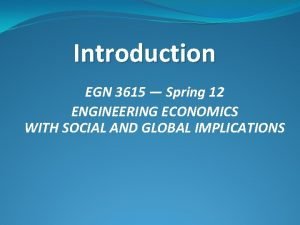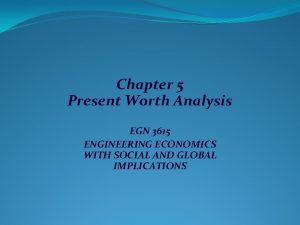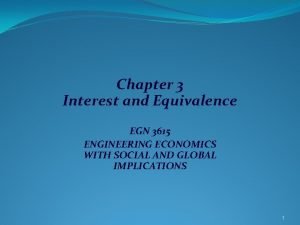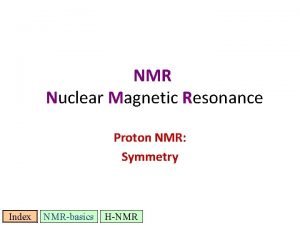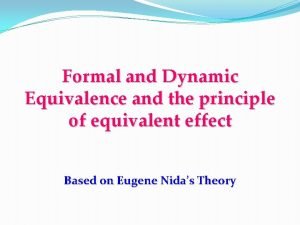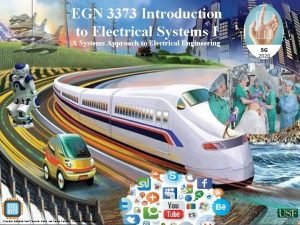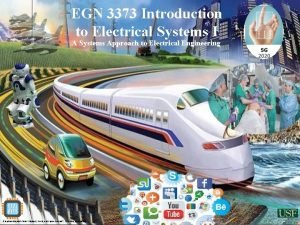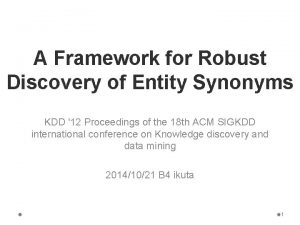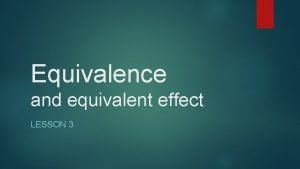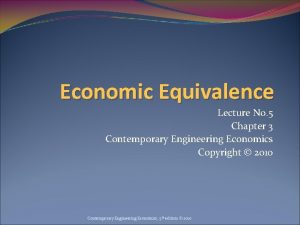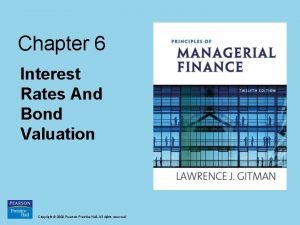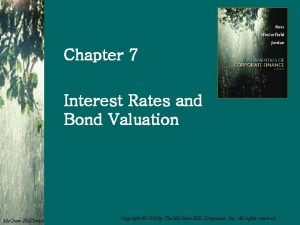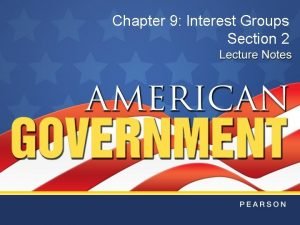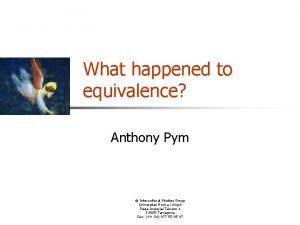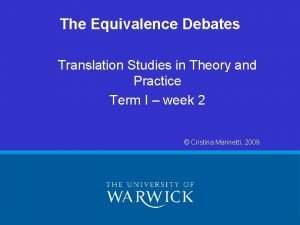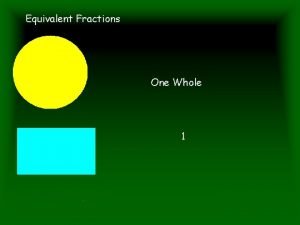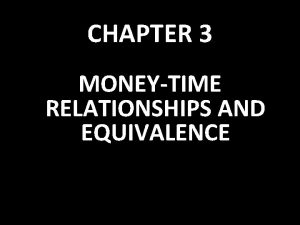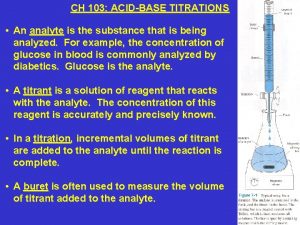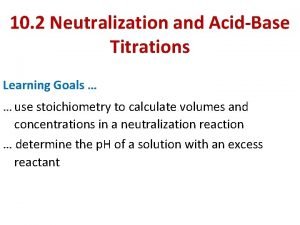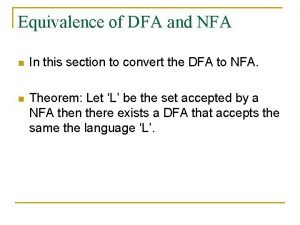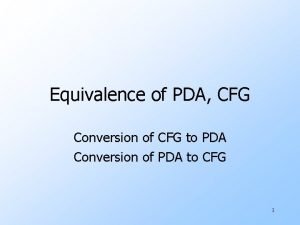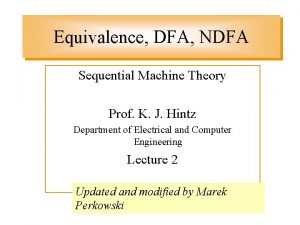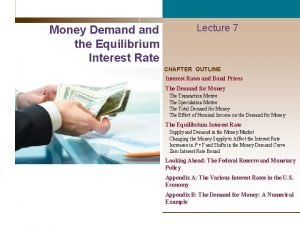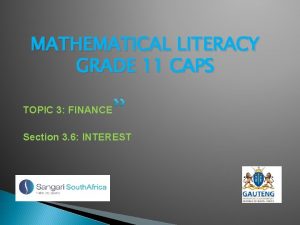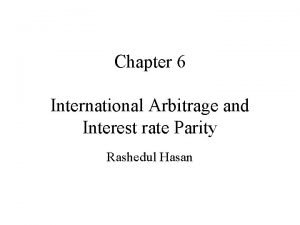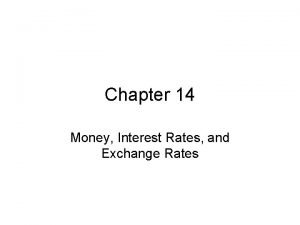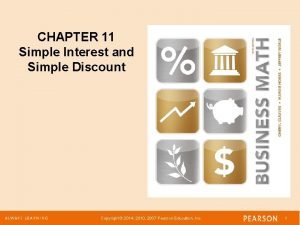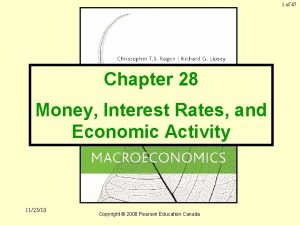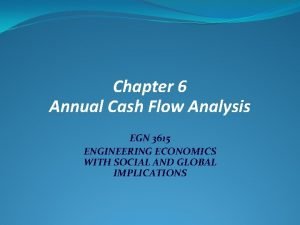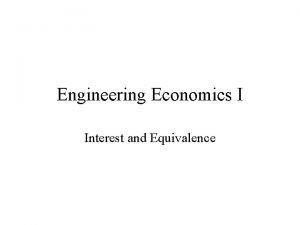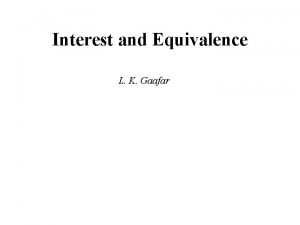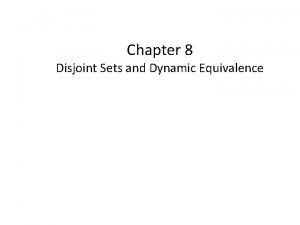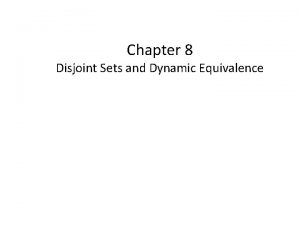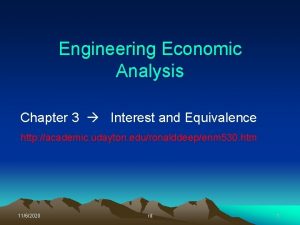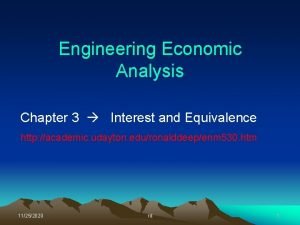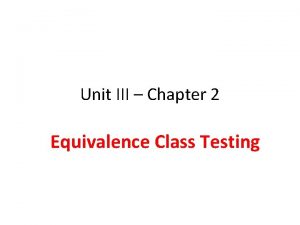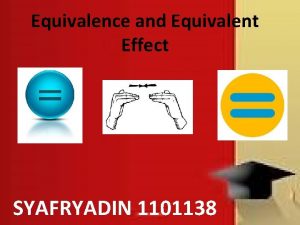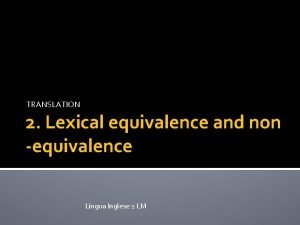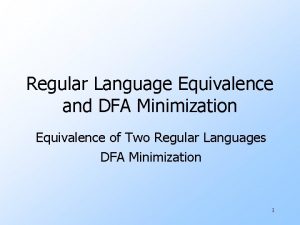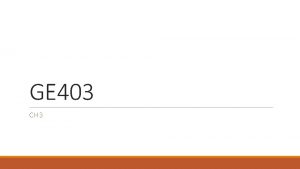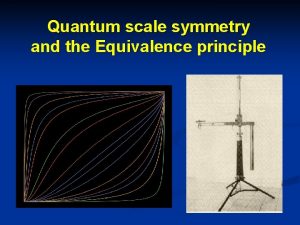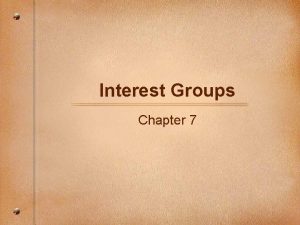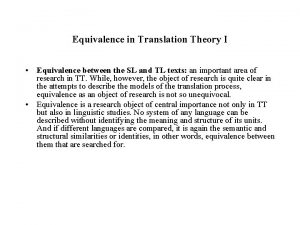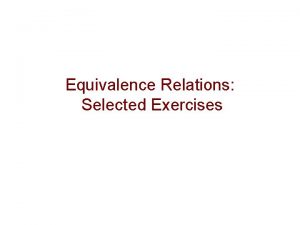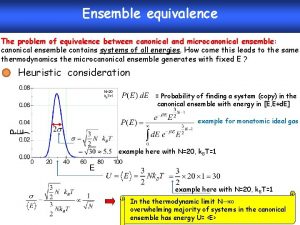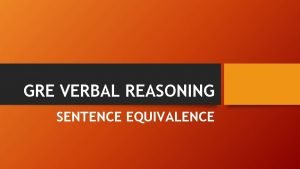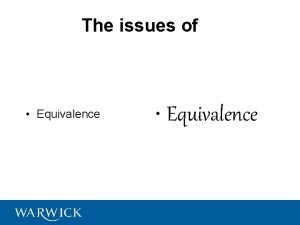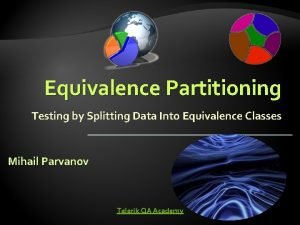Chapter 3 Interest and Equivalence EGN 3615 ENGINEERING














































- Slides: 46

Chapter 3 Interest and Equivalence EGN 3615 ENGINEERING ECONOMICS WITH SOCIAL AND GLOBAL IMPLICATIONS 1

Learning Objectives Understand the concept of “time value of money” Distinguish between simple and compound interest Understand the concept of “equivalence” of cash flows Solve problems using Single Payment Compound Interest Formulas Slide 2

Computing cash flow To purchase a new $30, 000 machine, two alternatives: Pay the full price now minus a 3% discount or Pay $5000 now; $8000 at the end of year 1; and $6000 at the end of each of the next 4 years (A total of $37, 000!) Why do the second? 0 1 2 3 4 5 0 $5, 000 $29, 100 1 2 3 4 5 $8, 000 $6, 000 Slide 3

Computing Cash flow (cont…) To repay a loan of $1, 000 at 8% interest in 2 years Repay half of $1000 plus interest at the end of year 1 Repay the remaining $500 plus interest at the end of yr 2 $1000 Yr Interest Balance Repayment 0 1000 Cash Flow 1000 1 2 -580 -540 80 40 500 500 0 1 $580 2 $540 Slide 4

Time value of money Money has purchasing power Money has earning power Money is a valuable asset People are willing to pay some charges (interest) to have money available for their use Money loses value in time! Or money has a time value! The time value lost over time is made up by “interest”! Slide 5

Interest Calculations Simple interest Total interest earned = (Eq. 3 -1) where P = Principal (loan) i = Simple annual interest rate n = Number of years (Eq. 3 -2) where F = Amount due at the end of n years Interest in computed on just the principal in each year! Slide 6

Simple interest (example) Loan of $10, 000 for 5 yrs at simple interest rate of 6% Total interest earned = $10000(6%)(5) = $3000 Amount due at end of loan = $10000 + $3000 = $13000 Although it is “simple”, it is rarely used. Slide 7

Compound interest Interest is computed on the unpaid balance (not just the principal), which includes the principal and any unpaid interest from the preceding period Common practice for interest calculation, unless specifically stated otherwise Slide 8

Compound interest (example) Loan of $10 K for 5 yrs at compound interest rate of 8% Balance Year Beginning of year Interest Balance at end of year 1 $10, 000. 00 $10000 x 0. 08 = $800. 00 $10, 000 + 800 =10, 800. 00 2 $10, 800. 00 $10, 800 x 0. 08 = $864. 00 $10, 800 + 864 =11, 664. 00 $11, 664 x 0. 08 = $933. 12 $11, 664 + 933. 12 =12, 597. 12 $12, 597. 12 x 0. 08 = $1007. 77 $12, 597. 12 + $1007. 77=13, 604. 89 $13, 604. 89 x 0. 08 = $1088. 39 $13, 604. 89 + $ 1088. 39=14, 693. 28 3 4 5 Slide 9

Repaying a debt �Repay of a loan of $5000 in 5 yrs at interest rate of 8% �Plan #1: Pay $1000 principal plus interest due Yr Balance at the Beginning of Year Interest Balance at the end of yr before payment Interest Payment Principal Payment Total Payment 1 $5, 000. 00 $400. 00 $5, 400. 00 $1, 000. 00 $1, 400. 00 2 $4, 000. 00 $320. 00 $4, 320. 00 $1, 000. 00 $1, 320. 00 3 $3, 000. 00 $240. 00 $3, 240. 00 $1, 000. 00 $1, 240. 00 4 $2, 000. 00 $160. 00 $2, 160. 00 $1, 000. 00 $1, 160. 00 5 $1, 000. 00 $80. 00 $1, 080. 00 $1, 000. 00 $1, 080. 00 $1, 200. 00 $5, 000. 00 $6, 200. 00 Subtotal Slide 10

Repaying a debt �Repay of a loan of $5000 in 5 yrs at interest rate of 8% �Plan #2: Pay interest due at end of each year and principal at end of 5 years Yr Balance at Beginning of Year Interest Balance at the end of Year Interest Payment Principal Payment Total Payment 1 $5, 000. 00 $400. 00 $5, 400. 00 $0. 00 $400. 00 2 $5, 000. 00 $400. 00 $5, 400. 00 $0. 00 $400. 00 3 $5, 000. 00 $400. 00 $5, 400. 00 $0. 00 $400. 00 4 $5, 000. 00 $400. 00 $5, 400. 00 $0. 00 $400. 00 5 $5, 000. 00 $400. 00 $5, 000. 00 $5, 400. 00 $2, 000. 00 $5, 000. 00 $7, 000. 00 Subtotal Slide 11

Repaying a debt �Repay of a loan of $5000 in 5 yrs at interest rate of 8% �Plan #3: Pay in 5 equal end-of-year payments Yr Balance at the Beginning of year Interest Balance at the end of yr before payment 1 $5, 000. 00 $400. 00 $5, 400. 00 $852. 28 $1, 252. 28 2 $4, 147. 72 $331. 82 $4, 479. 54 $331. 82 $920. 46 $1, 252. 28 3 $3, 227. 25 $258. 18 $3, 485. 43 $258. 18 $994. 10 $1, 252. 28 4 $2, 233. 15 $178. 65 $2, 411. 80 $178. 65 $1, 073. 63 $1, 252. 28 5 $1, 159. 52 $92. 76 $1, 252. 28 $92. 76 $1, 159. 52 $1, 252. 28 $1, 261. 41 $5, 000. 00 $6, 261. 41 Subtotal Interest Payment Principal Payment Total Payment Slide 12

Repaying a debt �Repay of a loan of $5000 in 5 yrs at interest rate of 8% �Plan #4: Pay principal and interest in one payment at end of 5 years Yr Balance at Beginning of year Interest Balance at the end of year 1 $5, 000. 00 $400. 00 $5, 400. 00 $0. 00 2 $5, 400. 00 $432. 00 $5, 832. 00 $0. 00 3 $5, 832. 00 $466. 56 $6, 298. 56 $0. 00 4 $6, 298. 56 $503. 88 $6, 802. 44 $0. 00 5 $6, 802. 44 $544. 20 $7, 346. 64 $2, 346. 64 $5, 000. 00 $7, 346. 64 Subtotal Interest Payment Principal Payment Total Payment Slide 13

Equivalence Total payment summary: Plan #1 Plan #2 Plan #3 Plan #4 Pay $1 K principal plus interest due $6, 200. 00 Pay interest at yr 1 -4, & balance at yr 5 $7, 000. 00 Make 5 equal payments at end of yr 1 -5 $6, 261. 41 Make one payment = balance at yr 5 $7, 346. 64 Slide 14

Equivalence The 4 repayment plans are equivalent to one another and to $5000 now at 8% interest Using the concept of equivalence, one can convert different types of cash flows at different points of time to an equivalent value at a common reference point Equivalence is dependent on interest rate Slide 15

Single payment. Compound interest formulas Notation: i = interest rate per compounding period n = number of compounding periods P = a present sum of money F = a future sum of money Single Payment Compound Amount Formula (Eq. 3 -3) (Eq. 3 -4) The above notation is read as Find F, given P, at i, over n Slide 16

Single payment. Compound interest formulas Solving for P in Eq. 3 -3 yields Single Payment Present Worth Formula (Eq. 3 -5) (Eq. 3 -6) The above notation is read as Find P, given F, at i, over n Slide 17

Simple payment. Compound interest formulas (ex. ) Wish to have $800 at the end of 4 years, how much should be deposited in an account that pays 5% annually? F = P(1+i)n F=800 P = F(1+i)-n = 800(1+0. 05)-4 Eq 3 -5 Eq. 3 -5 = $658. 16 0 1 2 i=5% P=? 3 4 Or P = F×(P/F, i, n) Eq. 3 -6 = 800(0. 8227) = $658. 16 Slide 18

Example 3 -5 $500 were deposited in a saving account, paying 6%, compounded quarterly, for 3 years — i, n, F F=? i = 6%/4 = 1. 5% - quarterly interest rate n = 3 x 4 = 12 quarters 0 1 2 11 i=1. 5% $500 12 F = P(1+i)n = P(F/P, i, n) = 500(1+0. 015)12 = 500(F/P, 1. 5%, 12) = 500(1. 196) = $598. 00 “…paying 6%. . . ” means paying annually. Slide 19

How much can you borrow if you can repay it in the two payments shown? Assume a 12% interest rate Solve for P, using Appendix C (or Eq. 3 -6) Year 0 1 2 3 4 5 Cash Flow +P 0 0 -400 0 -600 P = 400(P/F, 12%, 3) + 600(P/F, 12%, 5) = 400(0. 7118) + 600(0. 5674) = 625. 16 P=? 0 2 1 i=12% 3 400 4 5 600 Slide 20

With the same two payments shown, if the interest is increased to 15%, Will the value of P be larger or smaller? Solve for P Year 0 1 2 3 4 5 Cash Flow +P 0 0 -400 0 -600 P=? 0 2 1 i=15% 3 400 4 P = 400(P/F, 15%, 3) + 600(P/F, 15%, 5) = 400(0. 6575) + 600(0. 4972) = 561. 32 at 15% P = 625. 16 at 12% → P is smaller at 15% than at 12% 5 → Given future payments, P 600 decreases, as i increases! Slide 21

Problem 3 -2 Borrow $2000 Repay at end of 3 yrs, with 10% simple interest/yr How much to pay? Solution P = $2000, i = 10%, n = 3 yrs F = P(1+in) = 2000[1+0. 1(3)] = $2, 600 Slide 22

Problem 3 -11 Borrow $5 M Repay at end of 5 yrs, with 10% compound interest/yr How much to pay? Solution P = $5, 000, i = 10%, n = 5 yrs F = P(1+i)n = P(F/P, i, n) = 5 M(1+0. 1)5 = 5 M(F/P, 0. 1, 5) = 5 M(1. 61051) = $8, 052, 550 Slide 23

Problem 3 -18 Deposit $2 K in an account, & earn 6% interest How much is in the account (a) after 5 years? (b) after 10 years? (c) after 20 years? (d) after 50 years? (e) after 100 years? Slide 24

Problem 3 -18 Solution P = $2 k, and i = 6% (a) n = 5 F = P(1+i)n = P(F/P, i, n) = 2000(1+0. 06)5 = 2000(F/P, 0. 06, 5) = 2000(1. 338226) = $2, 676. 45 Slide 25

Problem 3 -18 Solution (b) n = 10 F = P(1+i)n = P(F/P, i, n) = 2000(1+0. 06)10 = 2000(F/P, 0. 06, 10) = $3, 581. 70 (c) n = 20 F = 2000(1+0. 06)20 = 2000(F/P, 0. 06, 20) = $4, 414. 27 Slide 26

Problem 3 -18 Solution (d) n = 50 F = 2000(1+0. 06)50 = 2000(F/P, 0. 06, 50) = $36, 840. 31 (e) n = 100 F = 2000(1+0. 06)100 = 2000(F/P, 0. 06, 100) = $678, 604. 17 Slide 27

Problem 3 -19 Inheritance amount of $20 k, interest rate is 7% How much is it worth, if it is received (a) after 5 years? (b) after 10 years? (c) after 20 years? (d) after 50 years? Slide 28

Problem 3 -19 Solution F = $20 k, and i = 7% (a) n = 5 P = F(1+i)-n = F(P/F, i, n) = 20000(1+0. 07)-5 = 20000(P/F, 0. 07, 5) = 20000(0. 712986) = $14, 259. 72 Slide 29

Problem 3 -19 Solution (b) n = 10 P = F(1+i)-n = P(F/P, i, n) = 20000(1+0. 07)-10 = 20000(P/F, 0. 07, 10) = $10, 166. 99 (c) n = 20 P = 20000(1+0. 07)-20 = 20000(P/F, 0. 07, 20) = $5, 168. 38 Slide 30

Problem 3 -19 Solution (d) n = 50 P = 20000(1+0. 07)-50 = 20000(P/F, 0. 07, 50) = $678. 96 (*) n = 100 P = 20000(1+0. 07)-100 = 20000(P/F, 0. 07, 100) = $23. 05 Slide 31

Single Payment Formulas Single payment compound amount formula F = P(1+i)n - given P, i, & n, find F. (3 -3) Single payment present worth formula P = F(1+i)-n - given F, i, & n, find P. (3 -5) Single payment interest formula i = (F/P)1/n – 1 - given P, F, & n, find i. Single payment time formula n = log(F/P)/log(1+i) - given P, F, & i, find n. Slide 32

Nominal & Effective Interest Nominal interest rate (per year), r Annual interest rate, without compounding, also called APR (annual percentage rate) Effective interest rate (per year), ia Annual interest rate with compounding ia = (1 + r/m)m – 1 (3 -7) m = # of compounding periods in a year m = 4, if compounding quarterly m = 12, if compounding monthly Slide 33

Nominal and Effective Interest Rate Question: What is the effective interest rate for 12% interest compounded monthly? 34

Nominal & Effective Interest Example 3 -9 A Bank pays 1. 5% interest quarterly What are r and ia? Solution Nominal annual interest rate, r = 4(1. 5%) = 6% Effective interest rate, ia = (1 + 0. 015)4 – 1 = 6. 14% Slide 35

Nominal and Effective Interest Rate Question: If you deposit $1000 in a bank that pays a 12% interest compounded quarterly what will be the amount you can withdraw in five equal yearly sums? In other words, how much should you withdraw each year? Solution r = 12% and m = 4 36

QUESTION CONTINUES 0 W W W 1 2 3 4 5 Given P, ia, n, find W. $1000 37

Nominal & Effective Interest Example 3 -10 Loan shark: “If I give you $50 on Monday, you own me $60 on the following Monday. ” (a) What are r and ia? (b) Starting with $50, how much is it worth after 1 yr? Slide 38

Nominal & Effective Interest Solution (a) Weekly interest rate = 60/50 – 1 = 0. 2 Nominal annual interest rate, r = 52(0. 2) = 10. 4 (b) Effective annual interest rate, ia = (1 + 0. 2)52 – 1 = 13, 103. 63 = 1, 310, 363% Year end worth F = Pia = 50(13103. 63) = $655, 181. 5 Slide 39

Continuous Compounding For nominal annual interest rate r, compounded continuously, effective annual interest rate is ia = e r – 1 (3 -14) Compound amount F = P(er)n = P[F/P, r, n] (3 -15) Present Worth (3 -16) P = F(er)-n = F[P/F, r, n] Slide 40

Continuous Compounding Again, F = P(er)n has quantities P, F, r, and n. Given any three, you can find the other one! 1) Given P, r & n, F = Pern. 2) Given F, r & n, P = Fe-rn. 3) Given P, F, & r, n = (1/r)ln(F/P). 4) Given P, F, & r, r = (1/n)ln(F/P). (3 -15) (3 -16) Slide 41

Continuous Compounding Example 3 -11 If a bank pays 5% nominal interest, compounded continuously, how much would $2000 be worth after 2 years? We can solve it by two methods! Slide 42

Example 3 -11 Solution Method 1: Use Eq. (3 -3) or (3 -4) (single payment compound interest formula) r = 5%, P = $2000, n = 2 ia = er – 1 = e 0. 05 – 1 = 0. 051271 F = P(F/P, ia, n) = 2000(1+0. 051271)2 = $2, 210. 34 Method 2: Use Eq. (3 -15) F = P[F/P, r, n] = 2000(e)0. 05(2) = $2, 210. 34 Slide 43

Continuous Compounding Example 3 -13 How long will it take for money to double at 10% nominal interest, compounded continuously? Solution This is the case that given P, F, & r, find n. In particular, F = 2 P, & r = 10%, n = (1/r)ln(F/P) = (1/0. 1)ln 2 = (10)(0. 693) = 6. 93 years Slide 44

Nominal and Effective Interest Rate Table below shows effective interest rates for various compounding periods with r = 12% Number of Length of Compounding Periods per year Effective Interest Rate 1 Annual 0. 12 2 Semiannual 0. 1236 4 Quarterly 0. 12551 12 Monthly 0. 12683 52 Weekly 0. 12734 365 Daily 0. 12747 Continuous 0. 12749 45

End of Chapter 3 Slide 46
 Egn 3615
Egn 3615 Present worth analysis example
Present worth analysis example Egn 3615
Egn 3615 Homotopic protons
Homotopic protons Formal equivalence
Formal equivalence Egn 3373
Egn 3373 Ideal diode
Ideal diode Egn synonym
Egn synonym Equivalence in difference jakobson
Equivalence in difference jakobson Nominal v. real interest rates
Nominal v. real interest rates Compound interest multiplier
Compound interest multiplier Nominal rate of interest
Nominal rate of interest Economic equivalence examples
Economic equivalence examples Forward engineering and reverse engineering
Forward engineering and reverse engineering Chapter 7 interest rates and bond valuation
Chapter 7 interest rates and bond valuation Chapter 5 bonds bond valuation and interest rates solutions
Chapter 5 bonds bond valuation and interest rates solutions Chapter 6 interest rates and bond valuation
Chapter 6 interest rates and bond valuation Chapter 7 interest rates and bond valuation
Chapter 7 interest rates and bond valuation Chapter 6 interest rates and bond valuation
Chapter 6 interest rates and bond valuation System procurement process in software engineering
System procurement process in software engineering Dicapine
Dicapine Engineering elegant systems: theory of systems engineering
Engineering elegant systems: theory of systems engineering Forward and reverse engineering
Forward and reverse engineering Chapter 9 section 1 the nature of interest groups
Chapter 9 section 1 the nature of interest groups Chapter 9 section 2 types of interest groups
Chapter 9 section 2 types of interest groups Pym equivalence
Pym equivalence Formal correspondence catford
Formal correspondence catford Fractions equivalent to 1/4
Fractions equivalent to 1/4 Money-time relationship and equivalence
Money-time relationship and equivalence Difference between endpoint and equivalence point
Difference between endpoint and equivalence point Phenolphthalein titration
Phenolphthalein titration Logical equivalence examples
Logical equivalence examples Equivalence of nfa and dfa
Equivalence of nfa and dfa Financial engineering notes
Financial engineering notes Pda to cfg
Pda to cfg Equivalence of dfa and ndfa
Equivalence of dfa and ndfa Logical form and logical equivalence
Logical form and logical equivalence Basic interests and hobbies
Basic interests and hobbies Definition de hobbies
Definition de hobbies Ssema
Ssema Money demand and interest rate
Money demand and interest rate Finance in maths lit grade 11
Finance in maths lit grade 11 What is an executory interest
What is an executory interest What is locational arbitrage
What is locational arbitrage Increase money supply
Increase money supply Simple interest and simple discount
Simple interest and simple discount Interest rates and price level
Interest rates and price level
